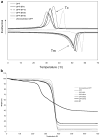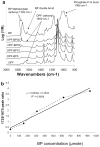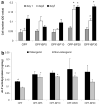Incorporation of phosphate group modulates bone cell attachment and differentiation on oligo(polyethylene glycol) fumarate hydrogel
- PMID: 22277774
- PMCID: PMC3970912
- DOI: 10.1016/j.actbio.2011.12.031
Incorporation of phosphate group modulates bone cell attachment and differentiation on oligo(polyethylene glycol) fumarate hydrogel
Abstract
In this work, we have investigated the development of a synthetic hydrogel that contains a negatively charged phosphate group for use as a substrate for bone cell attachment and differentiation in culture. The photoreactive, phosphate-containing molecule, bis(2-(methacryloyloxy)ethyl)phosphate (BP), was incorporated into oligo(polyethylene glycol) fumarate hydrogel and the mechanical, rheological and thermal properties of the resulting hydrogels were characterized. Our results showed changes in hydrogel compression and storage moduli with incorporation of BP. The modification also resulted in decreased crystallinity as recorded by differential scanning calorimetry. Our data revealed that incorporation of BP improved attachment and differentiation of human fetal osteoblast (hFOB) cells in a dose-dependent manner. A change in surface chemistry and mineralization of the phosphate-containing surfaces verified by scanning electron microscopy and energy dispersive X-ray analysis was found to be important for hFOB cell attachment and differentiation. We also demonstrated that phosphate-containing hydrogels support attachment and differentiation of primary bone marrow stromal cells. These findings suggest that BP-modified hydrogels are capable of sustaining attachment and differentiation of both bone marrow stromal cells and osteoblasts that are critical for bone regeneration.
Copyright © 2012. Published by Elsevier Ltd.
Conflict of interest statement
A non-provisional patent has been filed for photocrosslinkable oligo(polyethylene glycol) fumarate used in this research, and this technology has been licensed to BonWrx.
Figures










Similar articles
-
Phosphate functionalization and enzymatic calcium mineralization synergistically enhance oligo[poly(ethylene glycol) fumarate] hydrogel osteoconductivity for bone tissue engineering.J Biomed Mater Res A. 2020 Mar;108(3):515-527. doi: 10.1002/jbm.a.36832. Epub 2019 Nov 26. J Biomed Mater Res A. 2020. PMID: 31702863 Free PMC article.
-
Potential of hydrogels based on poly(ethylene glycol) and sebacic acid as orthopedic tissue engineering scaffolds.Tissue Eng Part A. 2009 Aug;15(8):2299-307. doi: 10.1089/ten.tea.2008.0326. Tissue Eng Part A. 2009. PMID: 19292677 Free PMC article.
-
Exposed hydroxyapatite particles on the surface of photo-crosslinked nanocomposites for promoting MC3T3 cell proliferation and differentiation.Acta Biomater. 2011 May;7(5):2185-99. doi: 10.1016/j.actbio.2011.01.034. Epub 2011 Feb 1. Acta Biomater. 2011. PMID: 21284960
-
Characterization of glycidyl methacrylate - crosslinked hyaluronan hydrogel scaffolds incorporating elastogenic hyaluronan oligomers.Acta Biomater. 2011 Feb;7(2):653-65. doi: 10.1016/j.actbio.2010.08.006. Epub 2010 Aug 13. Acta Biomater. 2011. PMID: 20709199 Free PMC article.
-
How cells sense extracellular matrix stiffness: a material's perspective.Curr Opin Biotechnol. 2013 Oct;24(5):948-53. doi: 10.1016/j.copbio.2013.03.020. Epub 2013 Apr 20. Curr Opin Biotechnol. 2013. PMID: 23611564 Free PMC article. Review.
Cited by
-
The Osteoinductive Effect of Controlled Bone Morphogenic Protein 2 Release Is Location Dependent.Tissue Eng Part A. 2019 Feb;25(3-4):193-202. doi: 10.1089/ten.TEA.2017.0427. Epub 2019 Jan 30. Tissue Eng Part A. 2019. PMID: 30101676 Free PMC article.
-
Injectable pH-responsive adhesive hydrogels for bone tissue engineering inspired by the underwater attachment strategy of marine mussels.Biomater Adv. 2022 Feb;133:112606. doi: 10.1016/j.msec.2021.112606. Epub 2021 Dec 13. Biomater Adv. 2022. PMID: 35525750 Free PMC article.
-
Injectable FHE+BP composites hydrogel with enhanced regenerative capacity of tendon-bone interface for anterior cruciate ligament reconstruction.Front Bioeng Biotechnol. 2023 Feb 23;11:1117090. doi: 10.3389/fbioe.2023.1117090. eCollection 2023. Front Bioeng Biotechnol. 2023. PMID: 36911205 Free PMC article.
-
Development of a Novel Marine-Derived Tricomposite Biomaterial for Bone Regeneration.Mar Drugs. 2023 Aug 28;21(9):473. doi: 10.3390/md21090473. Mar Drugs. 2023. PMID: 37755086 Free PMC article.
-
Recent Research on Hybrid Hydrogels for Infection Treatment and Bone Repair.Gels. 2022 May 16;8(5):306. doi: 10.3390/gels8050306. Gels. 2022. PMID: 35621604 Free PMC article. Review.
References
-
- Zouani OF, Chollet C, Guillotin B, Durrieu MC. Differentiation of pre-osteoblast cells on poly(ethylene terephthalate) grafted with RGD and/or BMPs mimetic peptides. Biomaterials. 2010;31:8245–53. - PubMed
-
- Zavgorodniy AV, Borrero-Lopez O, Hoffman M, Legeros RZ, Rohanizadeh R. Characterization of the chemically deposited hydroxyapatite coating on a titanium substrate. J Mater Sci Mater Med. 2011;22:1–9. - PubMed
-
- Zhang L, Ayukawa Y, Legeros RZ, Matsuya S, Koyano K, Ishikawa K. Tissue-response to calcium-bonded titanium surface. J Biomed Mater Res A. 2010;95:33–9. - PubMed
-
- Gandhi R, Davey JR, Mahomed NN. Hydroxyapatite coated femoral stems in primary total hip arthroplasty: a meta-analysis. J Arthroplasty. 2009;24:38–42. - PubMed
Publication types
MeSH terms
Substances
Grants and funding
LinkOut - more resources
Full Text Sources
Miscellaneous

